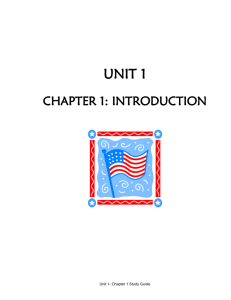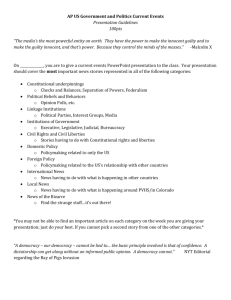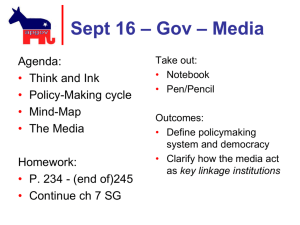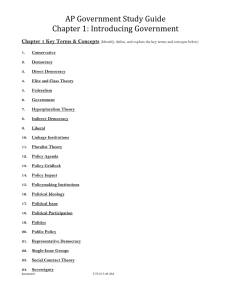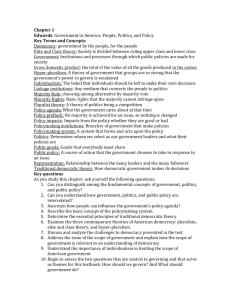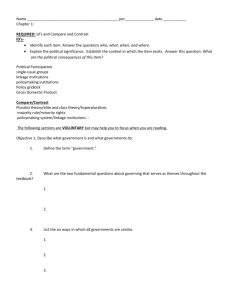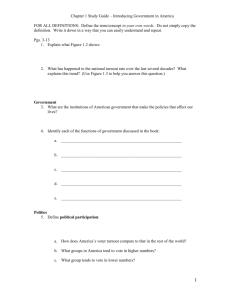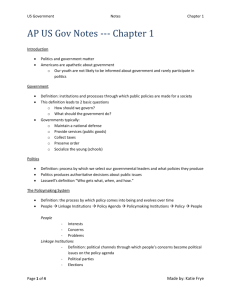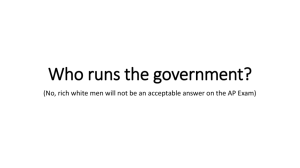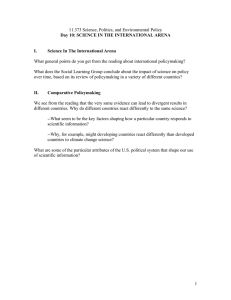Introducing Government in America
advertisement
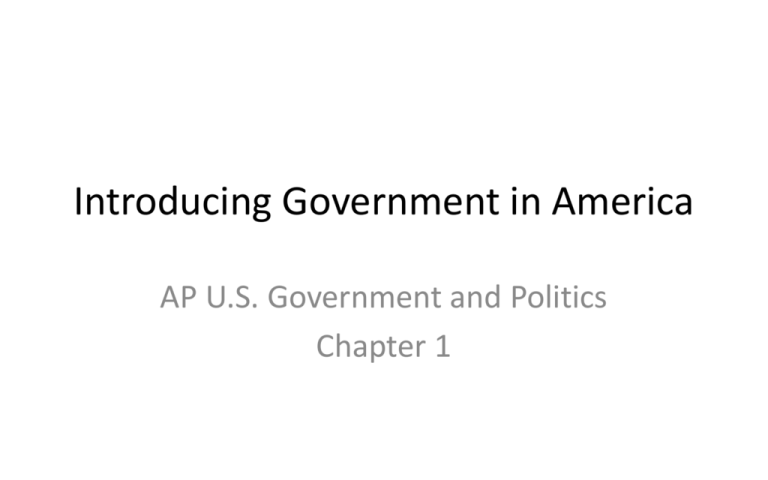
Introducing Government in America AP U.S. Government and Politics Chapter 1 Government • Government – the institutions through which public policies are made for a society. • Two fundamental questions about government: – How should we govern? – What should the government do? • Although citizens often disagree about what their government should do for them, all governments have certain functions in common. 1. 2. 3. 4. 5. Maintain National Defense Provide Public Goods and Services Preserve Order Socialize the young Collect taxes Politics • Politics – Process determining the leaders we select and the policies they pursue. • Politics produces authoritative decisions about public issues. • “Who gets what, when, and how.” – Harold D. Lasswell • The ways in which people get involved in politics make up their political participation. • Types of political participation: – – – – Voting Running for office Joining a single-issue group Others??? The Policymaking System • Government responds to the priorities of its people through the policymaking system. Linkage Institutions • Linkage institutions connect people with their government. – They are the channels through which people’s concerns become political issues on the policy agenda. – American linkage institutions: 1. 2. 3. 4. Elections Political parties Interest groups The media Policymaking Institutions • Policymaking Institution – The branches of government charged with taking action on political issues. – Three established by U.S. Constitution: 1. 2. 3. 4. Congress The Presidency The Courts Bureaucracy – Not in U.S. Constitution, but power is so great that many political scientists consider it a fourth policymaking institution or “fourth branch” of government. Public Policy • Public Policy – choices made by government in response to a political issue. • Policy impacts – effects a policy has on people and problems. Type Definition Example Congressional statute Law passed by Congress The $787 billion American Recovery and Reinvestment Act of 2009 is enacted. Presidential action Decision by President American troops are withdrawn from Iraq. Court decision Opinion by Supreme Court or other court Supreme Court rules that individuals have a constitutional right to own a handgun. Budgetary Choices Legislative act of taxes and expenditures The federal budget resolution is enacted. Regulation Agency adoption of regulation The Dept. of Education issues guidelines for qualifying for the federal student loan forgiveness program. Democracy in America • Democratic theory rests on several key principles. – Equality in voting – Effective Participation – Enlightened understanding – Citizen control of agenda – Inclusion • Democracies must practice majority rule while also protecting minority rights. Theories of Democracy • Theories of democracy focus on the question of “who really governs in our nation?” – Pluralism – policymaking process is open to participation of a variety of groups, with no single group dominating. – Elitism – upper-class elites hold power and make policy regardless of the formal government’s organization. – Hyperpluralism – theory stating that groups are so strong that government is weakened, crippling its ability to make policy. Challenges to Democracy • There are a number of continuing challenges to democracy. – Increased complexity of issues – Limited participation in government – Escalating campaign costs – Diverse political interests gridlock American Political Culture • According to Seymour Martin Lipset, American political culture can be summarized by five elements. 1. Liberty – individual freedom is fundamental to American life. 2. Egalitarianism – equality of opportunity. 3. Individualism – belief that people should and can get ahead on their own. 4. Laissez-Faire – free markets and limited government. 5. Populism - supports the rights of average citizens in their struggle against the elites. The Scope of Government in America • What role should government play in the lives of Americans? • Some Americans support a more active role for the government while others feel the scope of government needs to be smaller. – Facts about the size of our national government: • • • • It spends $3.7 trillion annually. It employs 2.8 million civilians and 1.4 million in the military. It owns about 1/3 of land in the U.S. It occupies over 3.2 billion square feet of office space.

